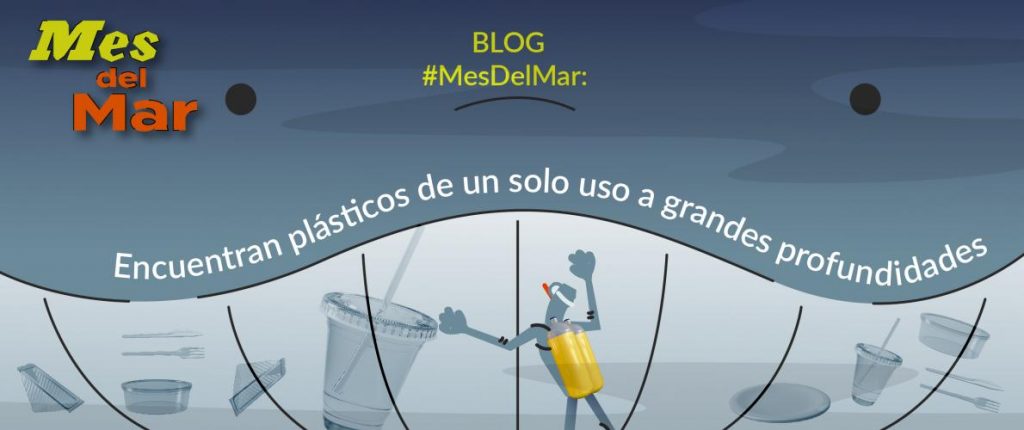TUE, 2021-05-04 16:56

Since the invention of plastics, more than 100 years ago, they have become a component present in virtually every aspect of people’s daily lives, from water bottles to construction materials and medical implements. Currently the global production of plastics is more than 300 million metric tons per year, which is expected to increase in the coming decades, while the flow of plastics into the ocean is equivalent to the dumping of a plastic garbage truck per minute .
According to estimates made in 2014, on the surface of the sea alone there would be more than five trillion pieces of plastic floating, which weigh more than 250 thousand tons. These estimates are conservative since, in addition, they do not consider plastics that do not float and are therefore found in the water column or on the seabed. Regarding the latter, a study published in the Marine Policy magazine in 2018, analyzed 30 years of audiovisual material from the depths of the sea, revealing that more than a third of the wastes found were plastics, of which 89% corresponded to plastics. single-use, even plastics being found at depths of 10,898 meters in the Mariana Trench.
Recently, a study by Nakajima and colleagues was published in the journal Marine Pollution Bulletin, in which the seabed was analyzed at great depths of up to 5,700 and 5,800 meters, in the Kuroshio Extension located in the Pacific Northwest. Through underwater filming, the authors of this publication were able to observe a reservoir of up to 4,561 plastic items per square kilometer, the most found being single-use items, mainly food bags and packaging.
This same proportion, that is, the predominance of single-use plastics within the waste found in our oceans is observed in the results of beach cleanings. Thus, both nationally and internationally, among the products most collected during these activities are single-use plastics, including bottles, their lids, food containers, wrappers and light bulbs.
It is worth mentioning that waste in the sea is a global environmental problem that threatens marine and coastal biodiversity. Three-quarters of these wastes are plastic, and impacts have already been observed at different levels of the marine ecosystem, affecting more than 800 marine and coastal species, through the ingestion of plastics, plastic gillnets, ghost fishing, dispersal species and habitat degradation.
Specifically, for the Southeast Pacific, at least 97 species have been documented to interact with plastic debris, including 53 species of seabirds, 20 species of fish, 19 marine mammals, and five species of sea turtles.
Taking these data into account, it is urgent to radically reduce plastic pollution, especially those that are used only once. Chile is close to approving a bill, promoted by Oceana and Plastic Oceans Chile, which aims to reduce the generation of waste and regulate single-use plastics, which would position us as one of the leading countries in this matter.
REFERENCES
Arredondo GA (2018) Plastic in the sea. Marina Magazine 964: 27-34.
Chiba S, H Saito, R Fletcher, T Yogi, M Kayo, S Miyagi, M Ojido & K Fujikura (2018) Human footprint in the abyss: 30 year records of deep-sea plastic debris. Marine Policy https://doi.org/10.1016/j.marpol.2018.03.022
DIRECTEMAR. National Report Cleaning of plasyas 2018.Available at: https: //www.directemar.cl/directemar/site/artic/20201221/asocfile/202012 …
Eriksen M, LCM Lebreton, HS Carson, M Thiel, CJ Moore, JC Borrero, F Galgani, PG Ryan & J Reisser (2014) Plastic pollution in the world’s oceans: more than 5 trillion plastic pieces weighing over 250,000 tons afloat at sea. PloS One 9 (12): e111913.
Nakajima R, M. Tsuchiya, A. Yabuki, et al. (2021) Massive occurrence of benthic plastic debris at the abyssal seafloor beneath the Kuroshio Extension, the North West Pacific
Author links open overlay panel. Marine Pollution Bulletin 166: 112188.
Ocean Conservancy. International Coastal Cleanup. Available at: https: //oceanconservancy.org/wp-content/uploads/2020/10/FINAL_2020ICC_Re …
Secretariat of the Convention on Biological Diversity (2016) Marine debris: understanding, preventing and mitigating the significant adverse impacts on marine and coastal diversity. CBD Tech. Ser. 83, Secr. CBD, Montreal, QC, Can. https://www.cbd.int/doc/publications/cbd-ts-83-en.pdf
Thiel M, G Luna-Jorquera, R Álvarez-Varas, C Gallardo, IA Hinojosa, N Luna, D Miranda-Urbina, N Morales, N Ory, AS Pacheco, M Portflitt-Toro & C Zavalaga (2018) Impacts of marine plastic pollution from continental coasts to subtropical gyres – fish, seabirds and other vertebrates in the SE Pacific. Frontiers in Marine Science 5 (238).
Worm B, HK Lotze, I Jubinville, C Wilcox & J Jambeck (2017) Plastic asa persistent marine pollutant. The Annual Reviews of Environment and Resources 42: 1-26.